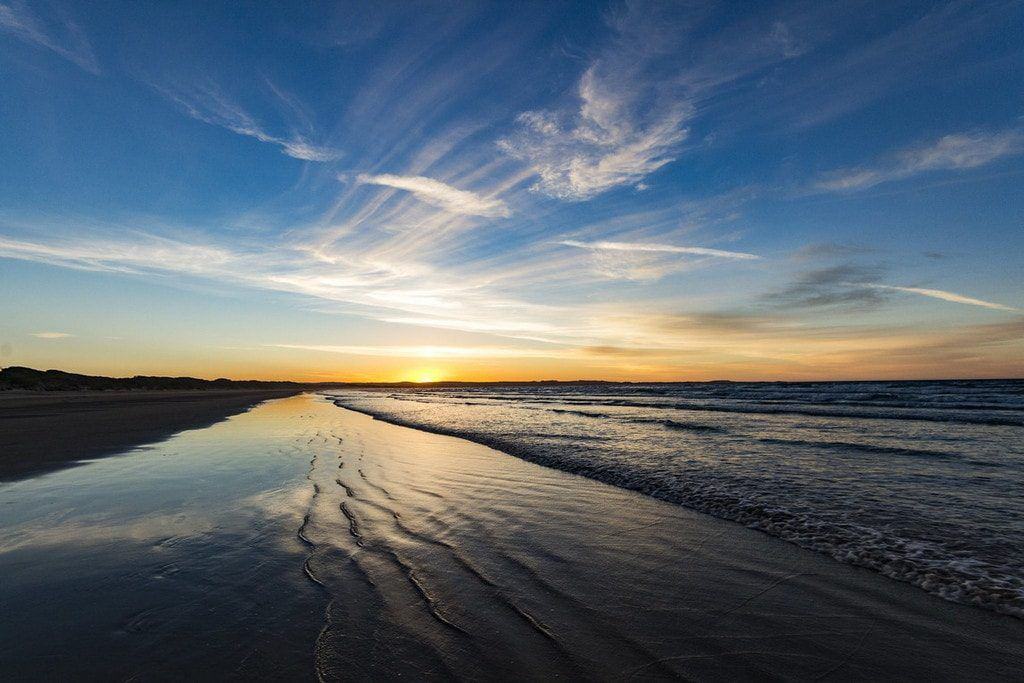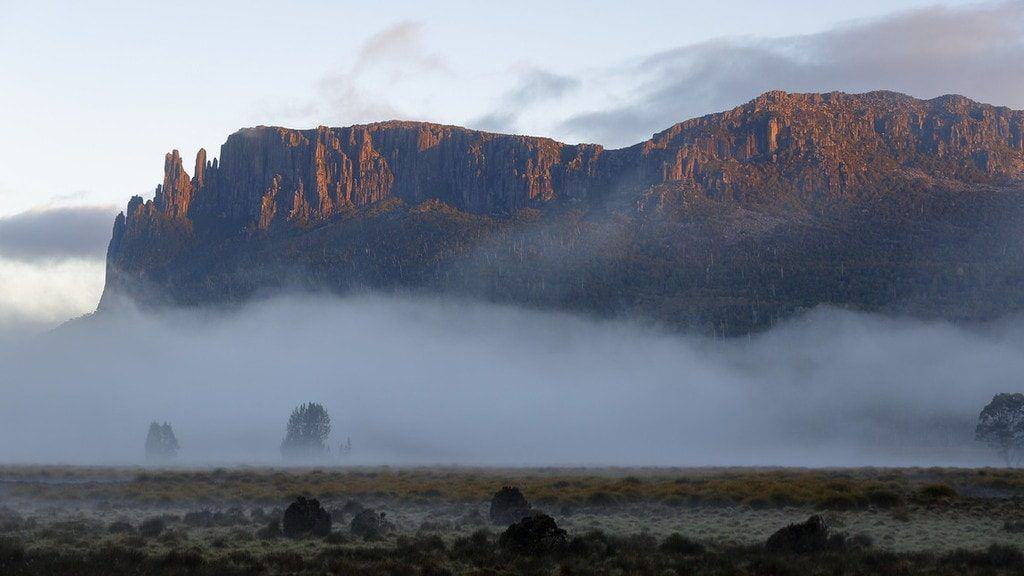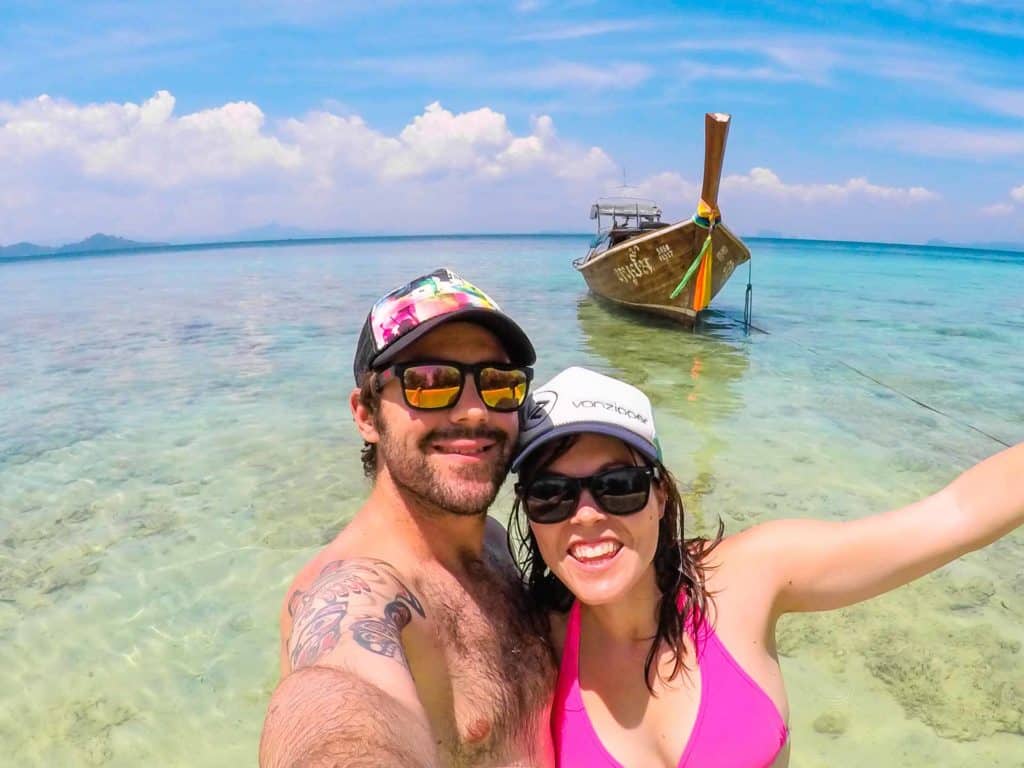Everything you need to know about camping in Tasmania as you prepare your Tasmania camping adventure: from itineraries and campgrounds to camping tips to packing lists!
Camping in Tasmania is often overshadowed by the myriad opportunities Australia provides a traveller.
But have you always dreamed of visiting Australia? Of camping under the stars and hiking epic landscapes?
So often it’s Great Ocean Road and Queensland that get all of the attention.
But did you know that around 40% of Tasmania is made up of mind-blowing national parks?
It has everything from mountains and crystal clear lakes, to white sandy beaches, beautiful bays, and dense forests. It also has famous sights like Wineglass Bay in Freycinet National Park, Bay of Fires, Port Arthur, Russell Falls, and Cradle Mountain.
This small island state has a lot to offer but skips the crazy driving distances for which Australia is known.
Want to cram maximum adventures into a short trip?
Tasmania is the perfect location for you.
It also has around 50 caravan parks and lots of amazing free camping for planning the ultimate road trip and camping holiday.
READ MORE: Check out our complete guide to the best places to visit in Tasmania!

Table of Contents
- My Camping in Tasmania Guide
- My Tasmanian Camping Itinerary
- 1) Wander Through Hobart
- 2) Visit Tasman National Park
- 3) Enjoy Freycinet National Park
- 4) Tour Bay of Fires
- 5) Stop in Launceston
- 6) Explore the Northern Coast
- 7) Look Out at the Edge of the World
- 8) Spend Time in Cradle Mountain National Park
- 9) Explore Native Heritage
- 10) Add a Few More National Parks to Your Itinerary
- The Four Best Tasmanian Campsites You Won’t Want to Miss
- 5 Things You Need to Know Before Camping in Tasmania:
My Camping in Tasmania Guide
While Australia is one of the dream countries for road tripping and camping, Tasmania is often overlooked.
It’s a bit of a hidden gem for travellers because so many who visit the mainland never make it down to one of the most untouched parts of the country.
Tasmania is wild, untamed natural beauty at it’s finest.
It even rivals the famous New Zealand landscapes with its epic views.
Want to breathe the crispest, cleanest air straight from Antarctica and stand on the Edge of the World looking out to Africa?
The only place to do it is Tasmania.
Not only is it unbelievably beautiful, but Tasmania is one of the easiest places in Australia to visit.
You can easily road trip the whole island on a budget with just a two-week itinerary.
Or you can spend months exploring the coastlines and enjoy luxury stays.
It’s perfect for any itinerary and offers a real blend of history and culture, awe-inspiring landscapes, adventure and ways to get active.
Plus the island boasts some amazing delicacies to tantalise your tastebuds.
Whether you want to climb a mountain, taste local oysters and wines, or see artwork that will blow your mind – there’s something for everyone.
How Long do you Need to Explore Tasmania?
Tasmania is very small and driving distances are short between popular locations.
You could easily spend 1-2 weeks road tripping around the island and visiting national parks.
Around 10 days is a perfect length of time to complete a full circle of the island and see all the incredible things to do in Tasmania.
Plan to spend a few days on Tasmania’s east coast around Wineglass Bay, Freycinet National Park, and the Bay of Fires and then round to the west and Cradle Mountain.
This will give you enough time to hike and explore the national parks (of which you can cover around 11 national parks in this time with ease).
But you will still have time to relax and explore the little towns and villages along the way.

My Tasmanian Camping Itinerary
This route can be completed in 10 days or two weeks. Or you could also spread it out over a month or longer.
It all depends on your budget and how much time you have available. These are 10 activities you want to plan while camping in Tasmania:
1) Wander Through Hobart
Start in beautiful Hobart and spend some time exploring the quaint colonial city.
Visit Salamanca Markets for the amazing local food, head up Mount Wellington for the beautiful views and don’t miss MONA (the Museum of Old and New Art)
I also recommend that you visit the Port Arthur Historic Site, which is the best preserved convict site in the country. You can visit Port Arthur as an easy day trip from Hobart.
2) Visit Tasman National Park
Drive down to Tasman National Park and enjoy your first glimpse of the stunning, untouched, east coastline on the Tasman Peninsula.
Plan for coastal camping, wildlife spotting and some amazing hiking trails.
Port Arthur is near this national park on the Tasman Peninsula, so stop by if you haven’t already!
3) Enjoy Freycinet National Park
Head up to Freycinet National Park where you can camp at Friendly Beaches and expect wild wallabies to come right up to your tent!
Spot whales migrating past the beaches, visit the lighthouse and spend time soaking up the beauty of these white, sandy beaches.
Honeymoon Bay is a particularly stunning and secluded spot for swimming and relaxing on the sand in Freycinet National Park. Honeymoon Bay is situated inside Coles Bay, so it’s a bay within a bay. Sleepy Bay is also beautiful.
And, of course, Freycinet National Park is home to the iconic Wineglass Bay, which is a must-see in Tasmania.
BONUS TIP: Rushed for time? Do a Freycinet National Park day trip here from Hobart!
4) Tour Bay of Fires
Afterwards, it’s up to Bay of Fires and you’ll be passing through Douglas-Apsley National Park, Ben Lomond National Park and up as high as Mount William National Park.
All offer incredible coastline, great hiking, epic views, swimming, wildlife and lots of amazing free camping sites. And the Bay Of Fires is one of the best places in Tasmania!
5) Stop in Launceston
Towards Launceston, you’ll be able to jump on the Cradle to Coast Tasting Trail which will take you to amazing local producers of wines, cheeses, fruit, meats and much more.
You can stop at Mountain Valley to spot wild platypus in the river.
Or head to Tamar Valley for more wine and local food tastings.
6) Explore the Northern Coast
In the north, you’ll find great walks and fascinating Aboriginal history at Rocky Cape National Park.
Plus why not stop around Devonport to explore, and head to Stanley to climb The Nut rock formation? (Or get the chair lift)
7) Look Out at the Edge of the World
Don’t miss the Edge of the World, and most western point of land until Africa, at Arthur River.
It’s absolutely incredible to stand on the very edge of the wild west coast where wind speeds have hit 200 kph and waves crash against the rocks.
You can visit the Edge of the World when doing the Tarkine Drive, which is an incredible adventure!
8) Spend Time in Cradle Mountain National Park
Now it’s down to Cradle Mountain National Park and the nearby Lake St Clair National Park – stock up on supplies before driving in.
Plan to spend two to three days in Cradle Mountain National Park if you want to enjoy a couple of hikes around the national park.
If you’re feeling brave and want amazing views from the top of Cradle Mountain, go for the popular hike and boulder scramble to the snowy summit for amazing lake views (not for the faint-hearted!).
If you’re running low on time you can also visit the national park on a great guided tour as a day trip from Launceston here.
9) Explore Native Heritage
Cruise through UNESCO site Franklin-Gordon Wild Rivers National Park for incredible Aboriginal heritage, mountains, forests and gorges.
Plan for lots of hiking, abseiling and climbing.
10) Add a Few More National Parks to Your Itinerary
Drive back through Mount Field National Park and Russell Falls for beautiful waterfalls and campsites on your way back to Hobart. Check out our travel guide about Mount Field National Park here.
Or you could head down to Hartz Mountains National Park, the nearby Southwest National Park, and South Bruny Island National Park if you have more time. Check our list of what to do on Bruny Island for some inspiration.

The Four Best Tasmanian Campsites You Won’t Want to Miss
While you will come across plenty of amazing places while camping in Tasmania. Camping sites are often the best accommodation options! These are the campgrounds that you definitely don’t want to miss.
1) Fortescue Bay Camping Ground, Tasman National Park
- $13 per adult, $2.50 for children, or $16 for a family.
- Access to showers, toilets and barbecues and a boat ramp. Untreated water available (boil before use).
- Ranger on site and dogs not allowed. Lots of wildlife around (no feeding).
- Unsealed road to access, but 4WD not necessary.
- Call ahead to book in peak season – (03) 6250 2433
2) Friendly Beaches Camping, Freycinet National Park, Coles Bay
- Free campsite, bush camping & very basic but directly at a beautiful beach.
- 25 camping spots suitable for tents, cars, motorhomes, camper vans and big rigs.
- No access to water or firewood, no showers, pit toilets available. No pets.
- Gets extremely busy over Christmas/New Year (peak season) so arrive early.
- Max stay 2 weeks and ranger on site.
- Nearest shops/facilities 20 km away in Coles Bay.
- Lots of wildlife – wallabies, kangaroos, wombats, pademelons and more.
3) Bay of Fires Conservation Area Camping, from Binalong Bay to Eddystone Point
- Cosy Corner is one of many amazing free camping spots along this section of the coastline near Binalong Bay and Bay of Fires.
- Southern end access is available from St Helen’s.
- Chemical toilet, no freshwater, no firewood.
- Full range of Aussie wildlife from kangaroos, wallabies and pademelons to wombats, sea eagles, echidnas and more.
4) Cradle Mountain Lake St Clair National Park
- One of the best camping destinations with easy access to the national park and hiking trails, plus one of the most beautiful areas to camp overlooking the lake.
- A range of different levels of camping spots from free bush camping spots to paid for camps with full facilities.
- Depending on where you stay, there are showers, toilets, barbecues, picnic tables, camp kitchens, laundries and kiosks available if you want.
- Pets are not allowed and bookings are essential around this area due to popularity during peak season.
- Limited drinking water available – it is best to fill up before arriving with enough water for hiking and cooking.
- The best campsites are found when hiking the Overland Track. Check out our detailed guide all about it.

5 Things You Need to Know Before Camping in Tasmania:
- If you are planning to visit any national park, you will need a National Parks pass. There are a few options, but the two month pass that costs $89.50 is the most popular. There are also annual and two-year options available online.
- Download the Wiki Camps app for Australia. It works offline so even if you have no phone signal, you will still be able to find a campsite. It also makes it really easy to see what facilities are nearby and find free camps and other accommodation options.
- Even if you’re travelling in the middle of summer – remember the weather is much more volatile here than on the mainland. Prepare for all weathers and bring lots of layers so you’re prepared for cold nights.
- Much of the island is protected and part of The Tasmanian Wilderness World Heritage Area. Follow basic guidelines while there: only camp where you are allowed, don’t feed the wild animals and look for signs before starting campfires.
- Despite being such a small island, national park areas and campsites can be very remote and don’t always have running water or phone signal. Be prepared and take all you need in your vehicle.
Should I Hire a Campervan or Pack a Tent?
The big decision that could make or break your trip – but should you choose comfort or accessibility?
When planning your visit to Tasmania, there are a lot of factors to take into consideration before choosing whether to camp or hire a van.
Hire a Camper Van
Picking a camper van or motorhome is one of the most comfortable accommodation options. It gives you the shelter and amenities that a tent just can’t provide.
You get the added benefits of indoor cooking and your own toilet/shower facilities which means you won’t have to rely on remote campsites to provide the goods.
It also means you can sleep in a proper bed after a day of hiking and can easily shelter from the unpredictable weather such as harsh winds and rain.
This is by far the biggest benefit when you arrive at some of the more exposed camping spots with rockier surfaces or marshy ground.
Finally, a camper van will also help you to keep any unwelcome visitors outside.
You will find a lot of very friendly wildlife around the campsites. This includes some rather cheeky wallabies and kangaroos, wombats and echidnas who are not shy and will come right up to the tents looking for food.
However, in exchange for these advantages do expect to pay a premium for the luxury of a camper van.
Top tip: Do your research when you know what time of year you will be visiting. Check weather patterns for both east and west of the island before deciding whether to camp or hire a van.
Pitch a Tent
While hiring a motorhome does sound perfect, make sure you consider all your options before booking.
There are also huge benefits to hiring a car and just taking a tent with you.
You can pitch in some amazing places with views of the ocean or mountains that you can’t always access as easily by car or by van.
It gives you the freedom to pitch up wherever you like and to take up a lot less space than you would with a van.
If you hire a car, it also means you can hire a 4WD if you decide you would like one for extra adventures (you don’t need 4WD for Tasmania).
If there’s a big group of you travelling together, it may be impractical to squeeze so many into motorhomes.
Instead, why not squeeze into cars and take bigger tents to share?
For backpackers or budget travellers, Australia can be expensive to travel and the cost of hiring a motorhome is an easily avoided spend.
There are $5 tents and cheap camping equipment readily available in supermarkets.
Australia also has fantastic free facilities including free BBQs overlooking the sandy beaches and free toilets/water.
READ MORE: Check out our guide to the top backpacking tents on the market to pick one that matches your needs.
Must-Have Camping Gear
Australia is one of the best countries in the world for camping spots. Campsites and caravan parks across often come very well-equipped.
But when it comes to Tasmania, it’s important to be prepared.
While many campsites and caravan parks will have toilets available, lots won’t have running water, firewood or showers (particularly if they are free ones).
Plan to be self-reliant and be prepared for remote campsites.
Before starting your trip, I also recommend stocking up on food at a supermarket in Hobart. When you reach the smaller towns and villages you will only have access to more expensive grocers.
Don’t forget to pack these key items:
- A big water tank and lots of big refillable bottles for hiking
- Gas stove and canister
- Plates, cups, cutlery and all your cooking equipment
- Sleeping bag suitable for low temps at night, plus a sleeping mat or blow up bed.
- Paper map as back-up for when phone signal fails
- Toilet roll and baby wipes – if you’re camping wild, these are life-savers!
- Rubbish bags – often campsites have a take your rubbish policy and don’t have bins because of wildlife. Take your rubbish away and use bins in towns.
- Warm clothes – thermals and lots of layers
- Hiking gear and good walking shoes/trainers.
- Waterproofs
- Food and snacks to keep you going for several days at a time. Choose simple – lots of veggies and staples like pasta, rice, and beans.
- Chilli-bin – that’s a cool box to anyone who’s not down with the Aussie lingo! Great for keeping your veggies fresh if you don’t have a fridge.

Other Tasmania Highlights You Won’t Want to Miss:
- The Cradle to Coast Tasting Trail. This is a food trail that takes you to the finest of fresh producers, cellar doors, market stalls and food festivals including award-winning favourites.
- Go platypus spotting! Australia’s weirdest animal can be found in Tasmania. I actually spotted four at Mountain Valley Private Nature Reserve.
- Stand on the Edge of the World. Head to Gardiner Point, Arthur River, where you will find a wild coastline and the most western landmass until you reach Africa.
- Find fairy penguins on Tasmania’s east coast! After all, the next landmass as you travel south would be Antarctica. You can also find Tasmanian Devils at a wildlife sanctuary near Hobart.
- Spot the Southern Lights! Aurora Australis is one of the most magical sights south of the equator. But even if you don’t get lucky, the stars alone here will blow your mind

